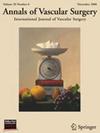急慢性肠系膜缺血的血管内治疗
IF 1.4
4区 医学
Q3 PERIPHERAL VASCULAR DISEASE
引用次数: 0
摘要
背景:肠系膜缺血需要及时有效的血运重建。血管内治疗(EVT)已成为一种完善的治疗方式,有几个好处。本文综述了当前EVT治疗急性和慢性肠系膜缺血(CMI)的方法。方法对肠系膜缺血的血管内治疗技术进行综述,包括血管成形术、支架置入术、取栓术、溶栓术、药物取栓术、局部血管扩张剂输注及混合入路。我们还评估了入路位置和术后处理。结果静脉穿刺治疗在肠系膜缺血的治疗中具有多种优势,有多种通路和技术可供单独或联合使用。EVT已经在很大程度上取代了CMI的开放血运重建术,并且在急性肠系膜缺血(AMI)中的应用也越来越多。每种方法的效用因疾病的慢性程度而异,具有不同的风险-收益概况。虽然短期结果是有利的,但长期的通畅率和再次干预的必要性仍然令人担忧。需要进一步的研究来比较开放和血管内重建术。结论evt为肠系膜缺血患者提供了多种血运重建选择,特别是对高危患者。虽然EVT具有良好的短期预后,但从长期来看,EVT可能与较高的再狭窄和再干预率相关,并且该疾病过程的总体死亡率仍然很高,特别是AMI。在血管内和开放手术入路之间的选择应根据患者因素、病变特征和外科医生或介入医生的专业知识进行个体化。需要进一步的前瞻性和随机试验来更好地阐明这种方法的结果并指导手术管理。本文章由计算机程序翻译,如有差异,请以英文原文为准。
Endovascular Management of Acute and Chronic Mesenteric Ischemia
Background
Mesenteric ischemia demands prompt and effective revascularization. Endovascular therapy (EVT) has become a well-established treatment modality with several benefits. This review examines current EVT options for managing acute and chronic mesenteric ischemia (CMI) in contemporary practice.
Method
A comprehensive literature review was conducted to evaluate endovascular techniques for mesenteric ischemia, including angioplasty, stenting, thrombectomy, thrombolysis, pharmacological thrombectomy, local vasodilator infusion, and hybrid approaches. We also evaluated access sites and postoperative management.
Results
EVT offers several advantages in the management of mesenteric ischemia, with various access sites and techniques available for single or combined use. EVT has largely replaced open revascularization for CMI and is increasing in use for acute mesenteric ischemia (AMI). The utility of each approach varies by disease chronicity, with different risk-benefit profiles. While short-term outcomes are favorable, long-term patency rates and the need for reinterventions remain concerns. Further research is needed to compare open to endovascular revascularization.
Conclusion
EVT provides diverse revascularization options for mesenteric ischemia, particularly for high-risk patients. While it has favorable short-term outcomes, EVT may be associated with higher rates of restenosis and reintervention in the long term and the overall mortality rates for this disease process remain high, particularly for AMI. The choice between endovascular and open surgical approaches should be individualized on patient factors, lesion characteristics, and surgeon or interventionist expertise. Further prospective and randomized trials are needed to better elucidate outcomes from this approach and guide operative management.
求助全文
通过发布文献求助,成功后即可免费获取论文全文。
去求助
来源期刊
CiteScore
3.00
自引率
13.30%
发文量
603
审稿时长
50 days
期刊介绍:
Annals of Vascular Surgery, published eight times a year, invites original manuscripts reporting clinical and experimental work in vascular surgery for peer review. Articles may be submitted for the following sections of the journal:
Clinical Research (reports of clinical series, new drug or medical device trials)
Basic Science Research (new investigations, experimental work)
Case Reports (reports on a limited series of patients)
General Reviews (scholarly review of the existing literature on a relevant topic)
Developments in Endovascular and Endoscopic Surgery
Selected Techniques (technical maneuvers)
Historical Notes (interesting vignettes from the early days of vascular surgery)
Editorials/Correspondence

 求助内容:
求助内容: 应助结果提醒方式:
应助结果提醒方式:


